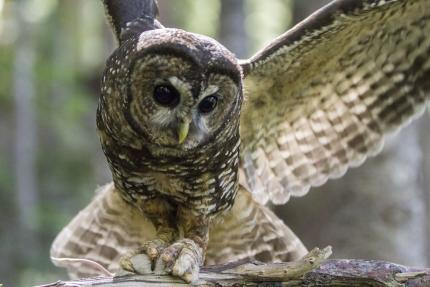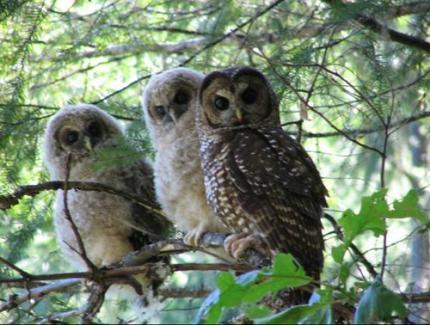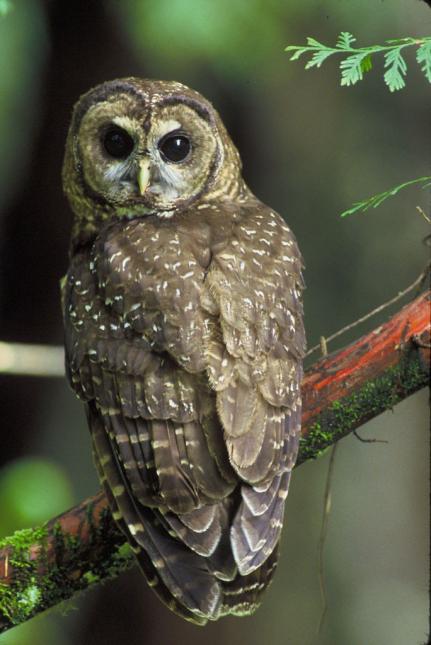Moderate-
High
Impacts from habitat loss of mature forest are now worsened by the effects of competition with barred owls for prey and habitat. As the population declines and becomes even smaller, other threat factors may become more relevant.
Description and Range
Physical description
Spotted owls are about 17 inches in length. They have large dark eyes, rounded heads, and are brown with white spotting overall. Spotted owls have a 4-note hoot. Physically, they may be confused with barred owls which are a few inches larger and have dark vertical barring on their light-colored breast. Barred owls also have a distinctive "who-cooks-for-you, who-cooks-for-you-all" call. Learn more about the differences between spotted owls and barred owls, hybridization, and gene research in this video.
Ecology and life history
The northern spotted owl inhabits mid and late seral coniferous forests. Typical habitat characteristics include:
- Generally high canopy closure
- Complex canopy structure involving trees of multiple age or size classes
- Large decaying trees and/or snags
- A high volume of downed wood.
The presence of mistletoe infection is important in the eastern Cascade Range.

Northern spotted owls have large home ranges, and in those areas they hunt a number of prey species. The most common prey are northern flying squirrels, but spotted owls will also prey on bushy-tailed woodrats, snowshoe hares, and other small mammals.
The northern spotted owl is relatively long-lived, has a long reproductive lifespan, invests significantly in parental care, and exhibits high adult survivorship. The majority of pairs do not breed every year. Courtship usually begins in February or March, and females typically lay eggs in late March or April.

Spotted owls are at a competitive disadvantage to the more generalist barred owl, which has expanded its range to now include the entire distribution of the northern spotted owl.
Geographic range
Formerly a widespread and uncommon resident of coniferous forests in western Washington and the east slope of the Cascade Range, the northern spotted owl is now rare throughout Washington. It has been very rare in southwestern Washington for several decades and no longer breeds in the Puget Lowlands. Northern spotted owls occur up to about 5,000 feet in elevation.
The population of northern spotted owls in Washington continues to decline, and some landscapes where long-term monitoring has been conducted now support several or fewer pairs. About 1,200 territories have been documented in Washington. Trend data suggests that about 25 percent or less of these territories remain occupied.
For maps of range-wide distribution and conservation status of this species, check out NatureServe Explorer and the International Union for Conservation of Nature Redlist.
Climate vulnerability
Sensitivity to climate change
Moderate-
High
This species exhibits some sensitivity to increased temperatures both directly (i.e., physiologically) and indirectly through effects on prey availability. This species also exhibits some sensitivity to altered disturbance regimes (i.e., fire and insect outbreaks) that lead to habitat changes. For example, in the eastern Cascades in Oregon, high severity wildfire has reduced the number of spotted owl pairs in a USFS Ranger Unit. However, it appears that dense old forests may be relatively stable on the west-side of the Cascades, while more active management may help address fire risk in dry east-side forests.
Exposure to climate change
- Increased temperatures
- Altered fire regimes
- Increased insect outbreaks
Conservation
Conservation Threats and Actions Needed
- Invasive and other problematic species and genes
- Threat: Competition with barred owls.
- Action: Management of barred owl populations to reduce competition.
- Fish and wildlife habitat loss or degradation.
- Threat: Loss of habitat.
- Action: Continue existing habitat protection measures and develop incentives to protect habitat on private lands.
See the Climate vulnerability section above for more information about the threats posed by climate change to this species.
Barred Owl Impacts on Northern Spotted Owls
Without managing barred owl populations and continuing to protect core habitats, northern spotted owls could become functionally extinct in Washington in the next decade.
Barred owls are classified by the U.S. Fish and Wildlife Service (USFWS) as an invasive species in WA, OR, and CA, due to their highly disruptive effect on native species and ecosystems. Barred owls are native to eastern North America, but human-driven changes to the landscape enabled barred owls to expand westward. They were first documented in Washington in 1972, and researchers have identified barred owl presence in northern spotted owl territories as the current primary threat to spotted owl survival, combined with historic habitat loss. Barred owls are larger, more aggressive, and more adaptable than northern spotted owls. They displace spotted owls, disrupt their nesting, and outcompete spotted owls for food.
Barred owls are also impacting other native wildlife in Washington. Barred owls are not simply replacing northern spotted owls in the food web. Their generalist diet, wider distribution and higher population densities are disrupting ecosystems that impact many other at-risk and endangered wildlife, including carnivores and their prey. The endangered Canada lynx and fisher are forced to compete with barred owls for important prey species like snowshoe hares, undermining recovery efforts. Increasing barred owl densities in Washington are likely impacting native species that are evolutionarily naive to its presence, through predation or competition for prey. Some of these species are species of greatest conservation need (SGCN), including band-tailed pigeon, pocket gopher species, shrews, western screech owl, western gray squirrel, ring-necked snake, and more.
Next steps in Barred Owl Management
- Barred owl management is one of the last tools remaining to help save northern spotted owls in WA, OR, and CA. If the threat of barred owls remains, no other management options alone will be able to effectively recover spotted owl populations in these areas.
- Barred owl management has the potential to impact less than one percent of the barred owl population in North America, while helping to prevent the extinction of northern spotted owls in Washington.
- USFWS has announced their Record of Decision and final Barred Owl Management Strategy to address the threat of the non-native and invasive barred owl to native northern and California spotted owls.
- As a cooperating agency, WDFW provided technical guidance on the USFWS’s Environmental Impact Statement (EIS) regarding policy implications, wildlife science, and management.
- WDFW supports USFWS' final Barred Owl Management Strategy, which includes humane lethal barred owl removal only in limited areas that are priorities for spotted owls.
More information and resources on barred owl management and barred owl impacts on northern spotted owls:
- Handout: Things to know about Barred Owls in Washington (PDF)
- 12/13 WDFW Presentation to Fish and Wildlife Commission:
- Presentation: Spotted Owl Resilience in Washington (PDF)
- Video Recording: Washington Fish and Wildlife Commission - TVW
- USFWS Barred Owl Management webpage
Resources
References
Buchanan, J. B. 2005. Spotted Owl (Strix occidentalis). Pp 217-218 in T. R. Wahl, B. Tweit, and S. G. Mlodinow (eds.) Birds of Washington: Status and Distribution. Oregon State University Press, Corvallis, OR, USA. 436 pp.
Gutiérrez, R. J., A. B. Franklin, and W. S. LaHaye. 1995. Spotted Owl (Strix occidentalis). The Birds of North America 179:1-28.
